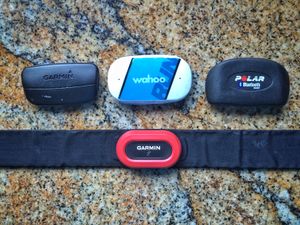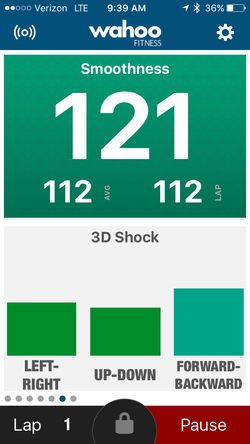Wahoo TICKR Run Review

The Wahoo TICKR Run is a heart rate monitor strap that will work with most Running Watches. It supports both of the major standards, Bluetooth and Ant+, as well as supporting some interesting extra running metrics. I think the TICKR is a good buy, though if you have a Garmin watch that supports it, their Running Dynamics heart rate strap might be a better option. The Wahoo TICKR Run is Error: Could not parse data from Amazon!.
- The Ant+ support allows the TICKR to work with Garmin running watches, as well as some others like the older Suunto Ambit2. In Ant+ mode it will only provide Heart Rate data, not any of the other additional functions (including Cadence).
- The Bluetooth transmission will work with a Smartphone as well as many other companies running watches. However, Bluetooth will only work with one device at a time, so you can't use it with a Smartphone and a running watch concurrently. If you're using a watch, the Bluetooth will only provide heart rate data.
- If you use the Wahoo app, you can get a number of additional running metrics. The TICRK will work with many other smartphone apps, but those other apps will only get the heart rate data. This is a major limitation when compared with Garmin's Running Dynamics that can display the metrics on a watch. It's tough to keep your eye on your phone when running outdoors.
- Rather like Garmin's Running Dynamics the TICKR will provide both Ground Contact Time and Vertical Oscillation.
- Cadence. This is probably the single most important metric in running, and this approach is more accurate than using the accelerometer built into a watch itself.
- Vertical Oscillation. This is how much the torso moves up and down with each stride. It is generally believed that less Vertical Oscillation is a better, but I suspect that this is an oversimplification. Some are part of a runner's vertical movement is likely to be elastic in nature (consider a bouncing rubber ball), some of the vertical motion will be while the runner is airborne (ballistic), and some of the vertical motion is the deceleration as the runner lands. So it seems likely to me that excessive vertical oscillation is bad, but it's a tricky to know what excessive is likely to be, or how to correct it.
- Ground Contact Time (GCT). The Science of Running Economy generally shows that longer Ground Contact Time is correlated with poorer Running Economy.
- One of the most interesting metrics is "smoothness" which is measured in three axes; forward-backward, up-down, and left-right. Smoothness is not a measure of acceleration, but rate of change of acceleration, also called "jerk". A high value of smoothness indicates low jerk, and could be related to both running economy and injury rates, though neither are proved. Sadly I couldn't get this to work for me (see testing below).
- The TICKR will transmit Heart Rate Variability data if you're interested in those metrics.
- The TICKR has LEDs for status which is rather unusual in heart rate straps. The blue LED shows Bluetooth pairing status (slow for unpaired, quick for paired, and 4 flashes for pairing), plus a red LED for each heartbeat. The LEDs only flash for about 30 seconds to save power.
- When using the Wahoo smartphone app you can tap the sensor to activate actions like recording a lap. This a nice feature, especially given the trickiness of using a phone when you're running.
- TICKR will estimate your distance for use with their app on a treadmill. This is an interesting approach, but its accuracy is dubious.
1 Testing
Here are the initial results of my testing of the TICKR.
- Heart rate looks accurate as you'd expect. I'll do some statistical analysis once I have sufficient data.
- Cadence also looks accurate and again, I'll do some statistical analysis after further testing.
- Vertical Oscillation matches other devices, but I've not independently verified it yet.
- Ground Contact Time (GCT) will require more analysis, but my initial results suggest it's measuring a bit shorter than reality (based on a comparison with high speed video.)
- Smoothness. This is the most interesting metric, and I've enjoyed getting useful and actionable real time feedback on my running form. However, I've hit a couple of issues. The first is that the smoothness value seems to depend directly on the tightness of the chest strap. If I have the strap as tight as I'd normally have a HRM strap the smoothness values are so bad they don't register right. If I tighten the strap so it's as short as it goes, my smoothness values start to get reported. If I tighten the strap by knotting it so that it's constraining my breathing then my smoothness values reach the "average" range. This problem is exacerbated by the way that my breathing changes the smoothness value; breath in and it reports I'm smoother than when I breathe out. The second issue is that I really want the metrics shown on a watch not my phone, as it's tough to run so you can keep an eye on even a small smartphone. The Wahoo app works well on a treadmill where you can prop your phone up or even use a tablet instead.
2 Data Export
The Wahoo fitness app will allow you to export your data as a CSV, which allows for more detailed analysis. Unfortunately the format is not documented, so I've had to reverse engineer it a little. The smoothness values are exported as ma_smoothness (overall average of the other three), ma_smoothness_x (left-right), ma_smoothness_y (up-down), ma_smoothness_z (back-forward). Wahoo claim these smoothness values are normalized so that an average runner has a smoothness of 100 in each axis. The values are also available as ma_jerkx, ma_jerky, ma_jerkz which look like the raw figures. Not surprisingly the up-down jerk are more than twice the magnitude of the other two.
